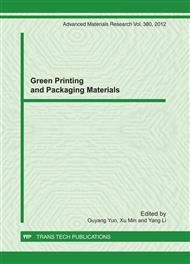p.3
p.7
p.11
p.15
p.20
p.24
p.29
p.35
Preparation of the Plastic Water-Based Gravure Primary Ink with High Pigment
Abstract:
The water-based gravure ink contains no volatile organic solvents and makes little environmental pollution, so it will be used widely as one promising environment-protecting ink. The dryness of water-based ink is always one hard point, because the printing carrier plastic hasn’t absorbability. To improve the dryness speed, the use of shallow version reducing the transfer is a common way. In order to reach the quality requirements of the graver press, the ink with high pigment is necessary. In this text getting printable ink samples, the primary ink that is dispersed by high-speed grinding is maxed with good- compatible water-based resin, co-solvent and auxiliary in proportion. Then getting the proof of the ink using IGT F1, the viscosity, size distribution, color density were tested . The influence of pigment/binder ratio to the viscosity, dispersibility and adherence of the ink were discussed. The result indicates that with the pigment/binder ratio promoting, the viscosity of the primary ink is decreasing. The dispersibility of primary ink is influenced by the pigment/binder ratio, when the pigment/binder is 2:1 ,the size of ink is the smallest. The pigment/binder ratio in primary ink has a certain influence to the adherence and the apparent performances of the ink. And the color density and the gloss of the proof are also influenced.
Info:
Periodical:
Pages:
15-19
Citation:
Online since:
November 2011
Authors:
Keywords:
Price:
Сopyright:
© 2012 Trans Tech Publications Ltd. All Rights Reserved
Share:
Citation:


